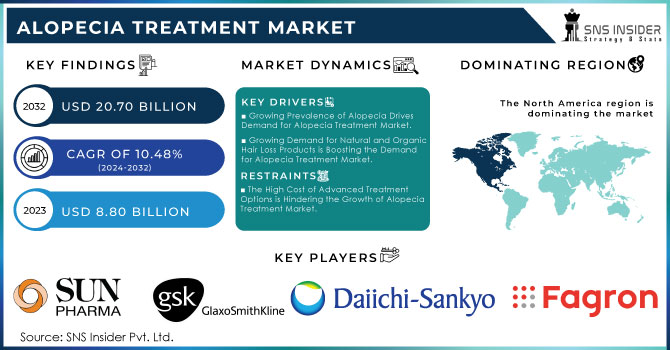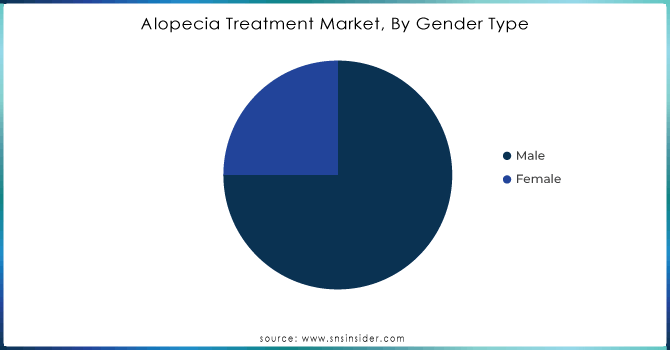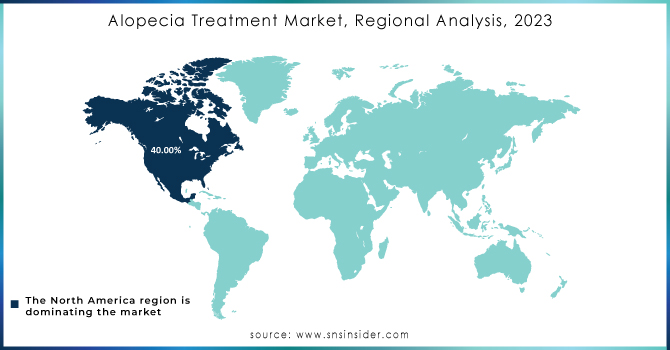Alopecia Treatment Market Report Scope & Overview:
The Alopecia Treatment Market Size was valued at USD 8.80 Billion in 2023, and is expected to reach USD 20.70 Billion by 2032, and grow at a CAGR of 10.48%.

Get More Information on Alopecia Treatment Market - Request Sample Report
The increasing prevalence of alopecia across the globe is one of the major factors boosting the growth of the alopecia treatment market. Increasing consumption of junk food, a sedentary lifestyle, and rising stress levels are the major reasons for the high rate of hair fall and hair damage. The disease is more prevalent in males. Increasing preference for aesthetic beauty is one of the reasons leading the population towards getting treatment for alopecia and boosting the alopecia treatment market. The International Society of Hair Restoration Surgery (ISHRS) reports that 35 million males in the U.S. are affected by hair loss each year. The increasing prevalence is expected to drive more individuals toward hair restoration treatment options. The launch of new products is also expected to attract the patient population to this market and boost the growth in this market throughout the forecast period. ISHRS also reports that the increase in the prevalence of the disease has helped improve overall hair restoration procedures by more than 60% since the year 2015. Hence, the rising prevalence of alopecia and the increasing patient pool are some of the factors that are expected to boost growth in this market.
MARKET DYNAMICS:
Key Drivers:
- Growing Prevalence of Alopecia Drives Demand for Alopecia Treatment Market.
- Growing Demand for Natural and Organic Hair Loss Products is Boosting the Demand for Alopecia Treatment Market.
Restraints:
- The High Cost of Advanced Treatment Options is Hindering the Growth of Alopecia Treatment Market.
- Side Effects and Limited Effectiveness of Certain Treatment Options Restraining Alopecia Treatment Market Growth.
Opportunity:
- Rising Adoption of Personalized Medicine and Genomic Therapies Presents Growth Opportunities for Alopecia Treatment Market.
- Significant Technological Innovations In Alopecia Treatment Options, Such As The Development Of Platelet-Rich Plasma (PRP) Therapy, Low-Level Laser therapy (LLLT), And Hair Cloning Techniques, Are Further Propelling Market Growth.
KEY MARKET SEGMENTATION:
By Route of Administration
The topical solution comprised 46% of the market in 2023, driven by increasing demand for alopecia treatment. These solutions come in various forms and are preferred for their availability and ease of use. The oral drugs segment dominated the market in 2023 and is expected to continue due to increased authorization for their use in alopecia treatment.
By Gender Type
Androgenic alopecia or hair loss is primarily present in males, which is why the male segment dominated the market with 75%. The increasing prevalence of androgenic alopecia is the most significant factor driving the growth of the segment. Moreover, the male patient population is rapidly growing across the globe, which is also contributing to the high share of this segment.
The female segment, in contrast, is expected to experience steady growth during the forecast period due to the skin infection-prone- the surface of the scalp, which results from the use of serums or lotions on hair. Both men and women are on the same pace of usage of alopecia treatments.

Need any customization research on Alopecia Treatment Market- Enquiry Now
By Age Group
The 18-34-year-old age group holds the largest share of the alopecia treatment market, accounting for 31% in 2023. This is due to the increasing number of young adults seeking alopecia treatment within this age Meanwhile range. Meanwhile, the 35–49-year-old segment dominated the market with 33% in 2023. This is attributed to the growing prevalence of alopecia among middle-aged individuals. Factors such as diabetes, hypertension, stress, a sedentary lifestyle, and other health conditions make people in this age group more susceptible to severe hair loss. These health conditions are among the major factors contributing to the development of alopecia in middle-aged individuals.
REGIONAL ANALYSIS:
North America dominated the regional shares in alopecia treatment in 2023 with a share of 40%. The key contributors are the high prevalence of the disease, increased awareness among consumers, proactive measures taken by the government, improvements in the healthcare infrastructure, and advancements in technology. Also, the rising adoption of laser-based therapy for treatment is one of the other factors leading to an increased treatment rate in North America. Also, the presence of several governments and a non-profit organization such as the National Alopecia Areata Foundation, Canadian Alopecia Areata Foundation, etc. that provide the guidelines and spread awareness among the people is expected to augment the market.

KEY PLAYERS:
The key market players are Sun Pharmaceutical Industries Ltd., Follicum AB, GlaxoSmithKline plc., Daiichi Sankyo, Fagron, Concert Pharmaceuticals Inc., Johnson & Johnson, bAclaris Therapeutics, Inc., Cipla Inc., Merck & Co., Inc. & other players.
RECENT DEVELOPMENTS
- In July 2023, REVIAN Inc. announced that the Revian Red Hair Growth System is expected to be in the second study. and it is also believed as an effective treatment option for Central Centrifugal Cicatricial Alopecia (“CCCA”).
- In June 2023, Pfizer Inc. announced the approval of LITFULO by the U.S. FDA. It is the first treatment that is approved and used for adolescents who are aged 12 and above to treat severe alopecia areata.
| Report Attributes | Details |
|---|---|
| Market Size in 2023 | US$ 8.80 Billion |
| Market Size by 2032 | US$ 20.70 Billion |
| CAGR | CAGR of 10.48% From 2024 to 2032 |
| Base Year | 2023 |
| Forecast Period | 2024-2032 |
| Historical Data | 2020-2022 |
| Report Scope & Coverage | Market Size, Segments Analysis, Competitive Landscape, Regional Analysis, DROC & SWOT Analysis, Forecast Outlook |
| Key Segments | •By Route of Administration (Topical, Injectable, Oral) •By Gender Type (Male, Female) •By Age Group (Below 18 years, 18 - 34 Years, 35 - 49 Years, Above 50 Years) •By End User (Hospitals and Physicians offices, Dermatology Clinics & Others) |
| Regional Analysis/Coverage | North America (US, Canada, Mexico), Europe (Eastern Europe [Poland, Romania, Hungary, Turkey, Rest of Eastern Europe] Western Europe] Germany, France, UK, Italy, Spain, Netherlands, Switzerland, Austria, Rest of Western Europe]), Asia Pacific (China, India, Japan, South Korea, Vietnam, Singapore, Australia, Rest of Asia Pacific), Middle East & Africa (Middle East [UAE, Egypt, Saudi Arabia, Qatar, Rest of Middle East], Africa [Nigeria, South Africa, Rest of Africa], Latin America (Brazil, Argentina, Colombia, Rest of Latin America) |
| Company Profiles | Sun Pharmaceutical Industries Ltd., Follicum AB, GlaxoSmithKline plc., Daiichi Sankyo, Fagron, Concert Pharmaceuticals Inc., Johnson & Johnson, bAclaris Therapeutics, Inc., Cipla Inc., Merck & Co., Inc. and other players |
| Key Drivers | •Growing Prevalence of Alopecia Drives Demand for Alopecia Treatment Market. •Growing Demand for Natural and Organic Hair Loss Products is Boosting the Demand For Alopecia Treatment Market. |
| RESTRAINTS | •The High Cost of Advanced Treatment Options is Hindering the Growth of Alopecia Treatment Market. •Side Effects and Limited Effectiveness of Certain Treatment Options Restraining Alopecia Treatment Market Growth. |

